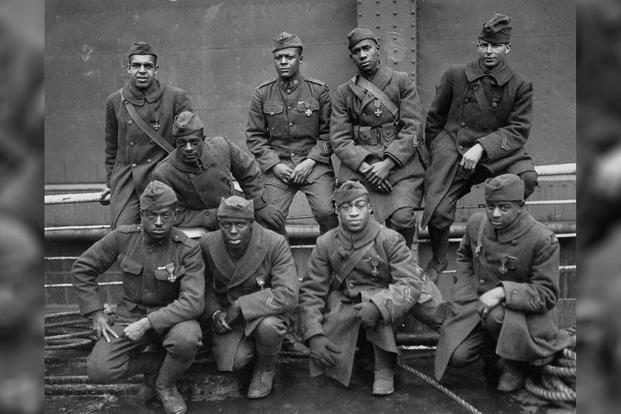SARATOGA SPRINGS, N.Y. (Nov. 18, 2014) -- Armanie Rallis, a box maker from St. Thomas, Virgin Islands, living at 2229 5th Avenue, was 20 when he joined Battery G of the 369th Coast Artillery Regiment in October 1939.
Garvey James, a 35-year-old post office clerk who served with the 548th Engineer Service Battalion -- cutting firewood for American soldiers in France after World War I ended -- reenlisted in the 369th Infantry in May 1924. But the Jamaica native apparently decided he was tired of part-time military service; in January 1927, he was dropped from the roles for "desertion." He stopped showing up for training.
And 29-year-old Arthur Curtiss was a fountain pen buffer -- keeping the nibs on expensive fountain pens working -- and a U.S. Navy veteran of World War I (service from 1916-19) when he reenlisted in the 369th Infantry Regiment in April 1928. Curtiss was reduced from corporal to private in March 1930 but was then promoted to sergeant in August 1930 before being honorably discharged in 1931.
These stories, and 2,593 more about members of New York's historic 369th Infantry Regiment -- recently featured in the Max Brooks graphic novel "The Harlem Hellfighters" -- are now available online.
The 369th Infantry -- originally formed as the 15th regiment of the New York National Guard -- was one of the few Black regiments that saw combat during World War I. The segregated U.S. Army didn't want the African-American soldiers, but the French did, and the men of the 369th earned a regimental Croix de Guerre from the French government and hundreds of individual medals during 191 days in the front lines.
When the soldiers came home from France, the 369th once again became part of the New York National Guard, and information about soldiers' service in the 369th -- first as infantrymen and then as coast artillerymen when the unit was reorganized -- was recorded on a document called a regimental personnel card.
New York State Military Museum staffers found more than 10,000 of these cards, dating from 1921 to 1949, as they were going through old records maintained at the New York National Guard's Harlem Armory, now the home of the 369th Sustainment Brigade, said Jim Gandy, the museum's librarian.
Thanks to assistance from New York's 3R's library councils - a nonprofit that works with libraries to improve library services - and a network of Military Museum volunteers, 2,596 of the cards were scanned. The information was organized on a spreadsheet and uploaded to the New York State Heritage Digital Collections website.
The goal is to make these materials, and those from other libraries and museums available to people around the state and eventually around the country, said Susan D'Entremont, digital project manager for the Capital District Library Council.
The New York Military Museum has already posted Civil War soldiers' photographs on the Heritage Digital Collections site. Those pages are very popular and very commented on, D'Entremont said.
In the days before computers, the 5-inch by 8-inch regimental personnel card provided a quick way for personnel officers to track enlistments and promotions of National Guard soldiers.
The information on the cards included age, address, place of birth, civilian job, prior military service, height, hair color, eye color, enlistment or reenlistment dates, the name of the officer who enlisted or reenlisted the soldier and information on promotions, reductions in rank and the number of recruits the s oldier brought into the National Guard.
There was also space to put in information about disciplinary actions or awards. In later versions of the cards, there is space for weapons qualification information.
This is invaluable information for people researching family histories and genealogists, Gandy said.
While it's easy to scan in the cards, the real work comes in recording the digital information, or metadata, that allows computer users to search online, Gandy said.
To do that time-consuming necessary work, Gandy turned to a group of volunteers who have helped with other digitizing projects the museum has conducted, including a complete online listing of 20,000 New York National Guard members mobilized in October 1940 as World War I loomed.
One of those volunteers is Greta Hamilton, a retired Air Force major and director of the Marion National Cemetery in Marion, Illinois.
She first became aware of the New York Military Museum in 2007 when she was working on a master's degree, living in Missouri and researching the 369th Infantry. As a Black veteran herself, Hamilton said she felt an affinity for the 369th, and when she learned that Gandy was looking for help in museum projects, she volunteered.
Gandy emails her and the other volunteers the scanned images of the cards, and she and the other volunteers type the data from the cards into spreadsheets, Hamilton said. When the spreadsheet is done she sends it back.
Getting this metadata recorded is essential to making digital archives work, D'Entremont said.
Working through the 369th personnel records has been fascinating, Hamilton said.
Her great-uncle served in the 92nd Infantry Division, an all-Black division that fought in France, so she is very interested in the experience of Black Soldiers during and after that war, she said.
She's also been intrigued by how interesting the men who joined the 369th were, Hamilton said.
"I am just amazed at the diversity of jobs that they held and that they came from different parts of the United States or the British West Indies. It was amazing to me how diverse and how educated these guys were," she said.
With the first batch cards online, the New York Military Museum volunteers will now start working on the next 2,500 cards, Gandy said. Eventually, all of the more than 10,000 cards will be available on the New York Heritage website and on the New York State Military Museum site as well, Gandy said.















